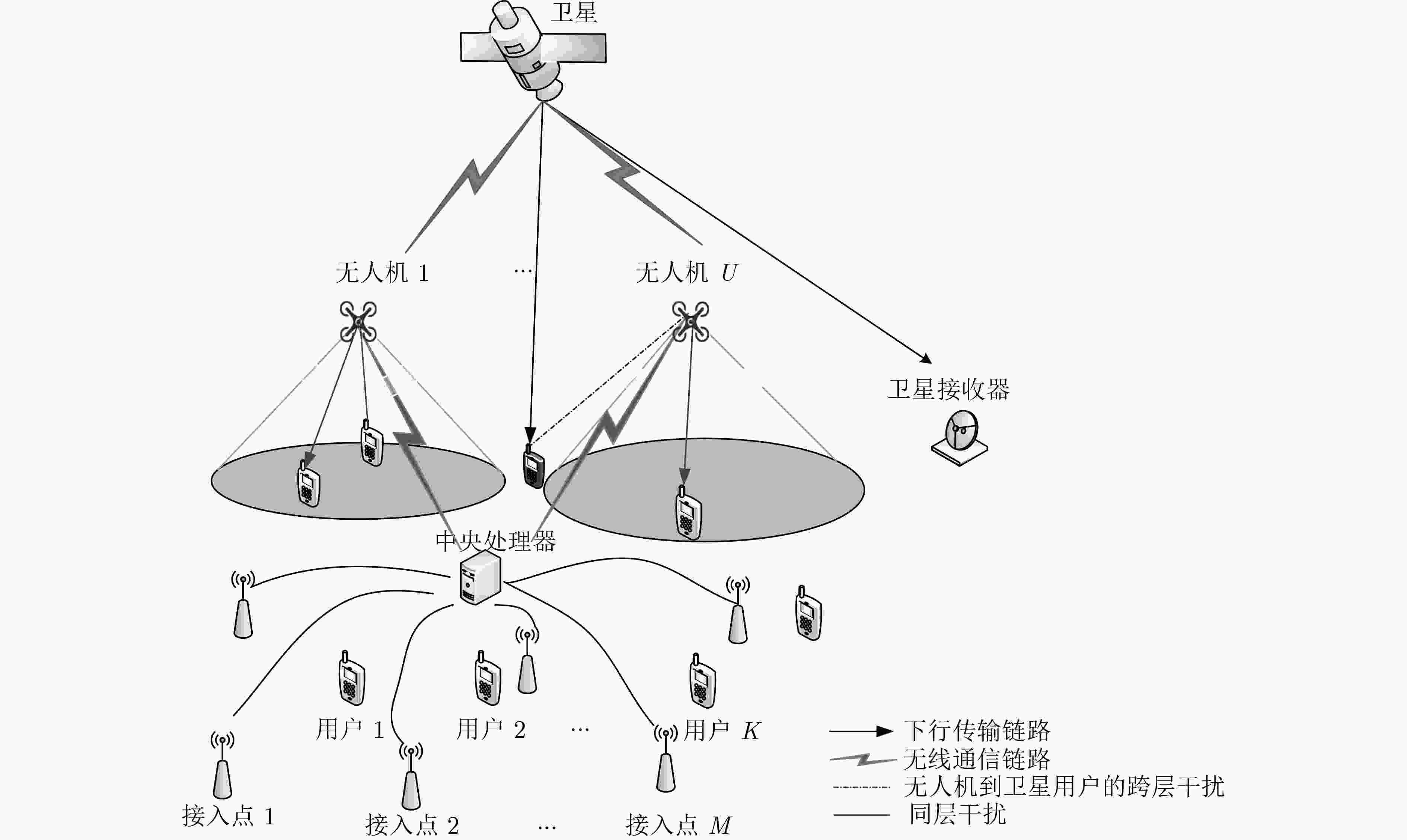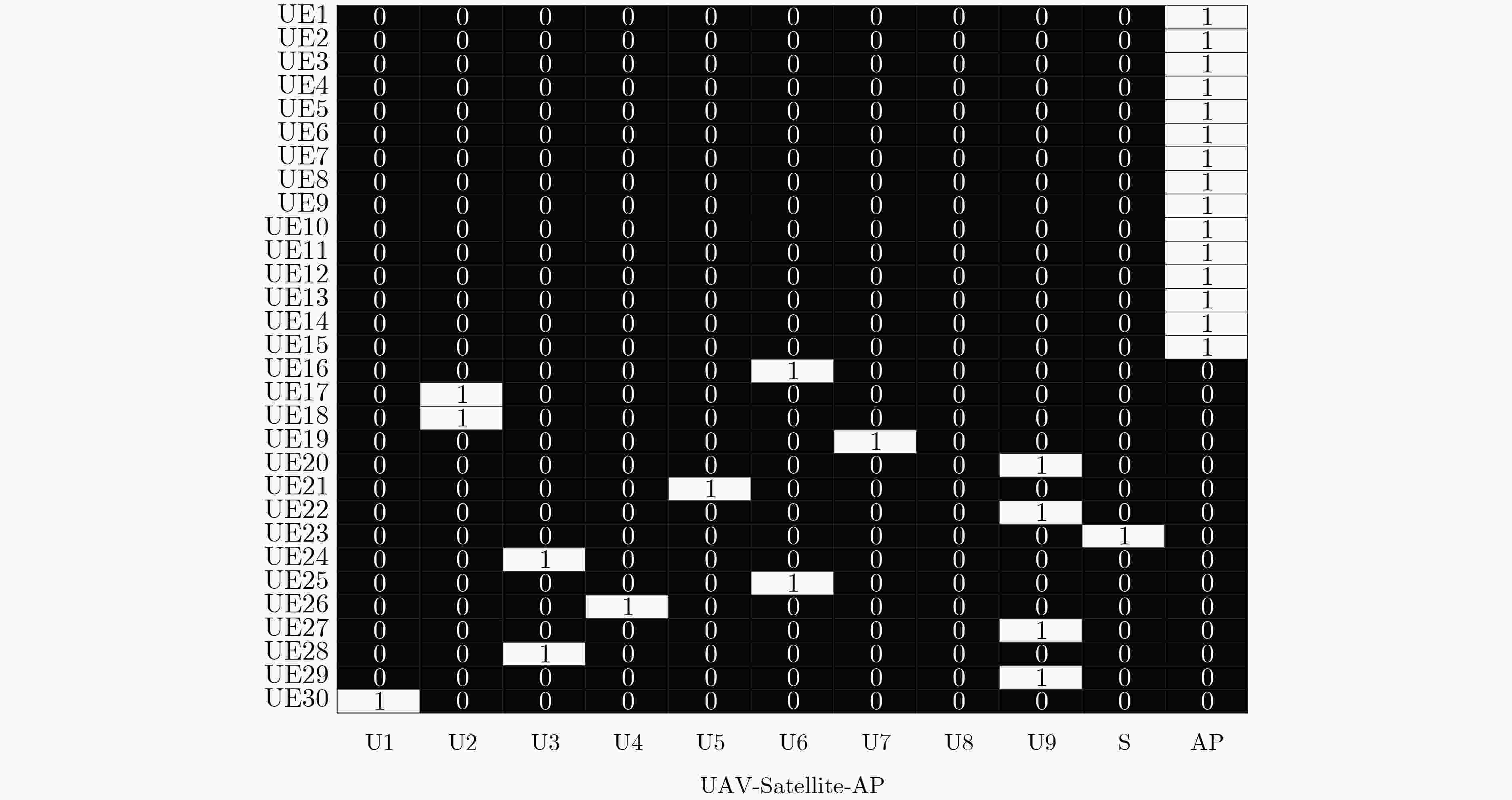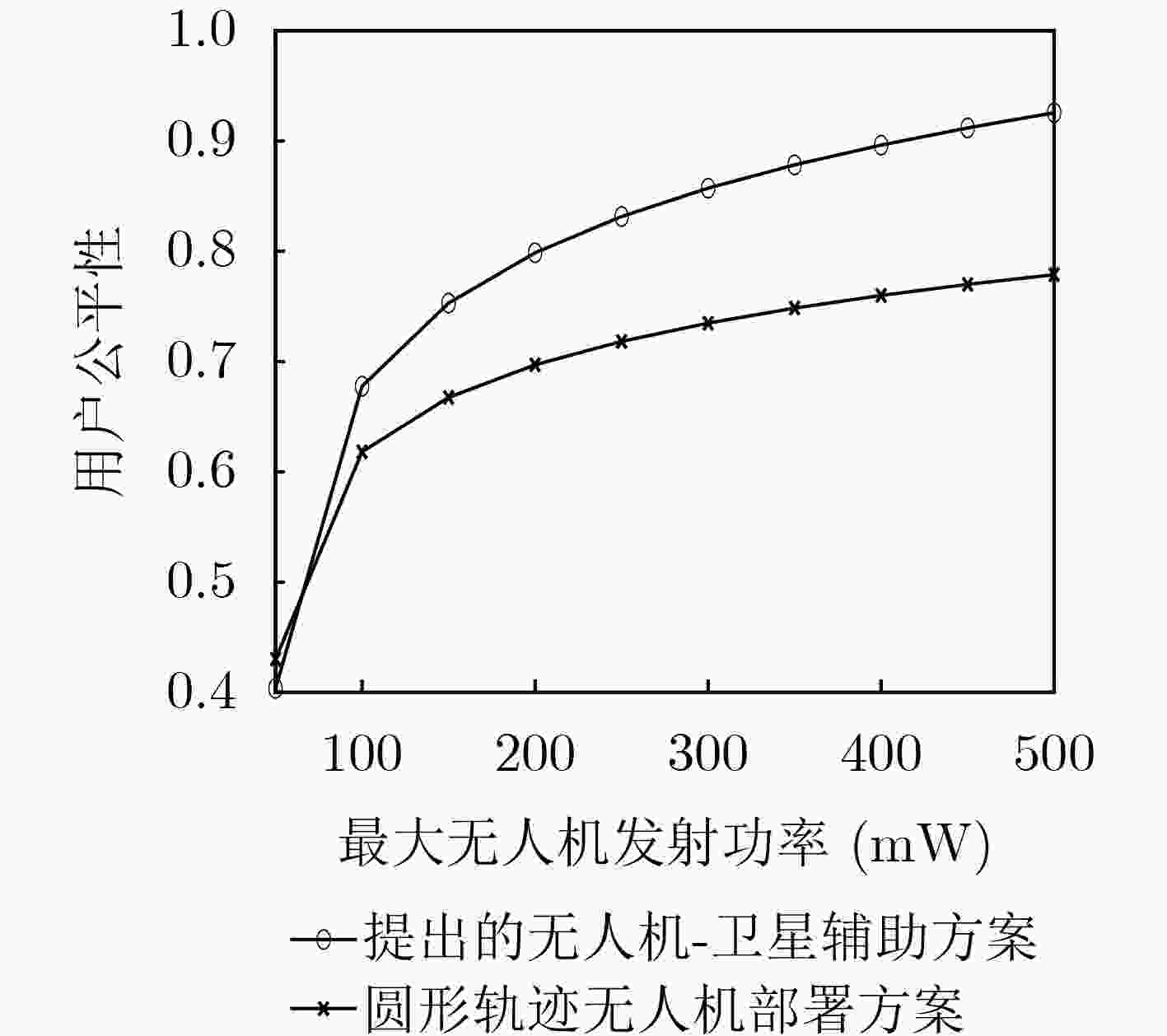Jointly Optimized Deployment and Power for Unmanned Aerial Vehicle - Satellite Assisted Cell-Free Massive MIMO Systems
-
摘要: 为了解决传统去蜂窝大规模多输入多输出(CF-mMIMO)通信系统认知局限、资源短缺、覆盖盲区的问题,针对传统覆盖受限的去蜂窝网络下行传输系统,该文提出无人机-近地轨道卫星辅助的空天地一体化CF-mMIMO的功率分配和无人机位置部署方法。根据已知的用户位置以及地面接入点的部署缺陷,考虑各通信接入点的覆盖约束、最大功率约束、跨层干扰约束,以最大化用户最小速率为目标,建立联合用户关联、功率分配以及无人机放置的混合资源分配模型。基于块坐标下降方法和连续凸优化方法,将原本的非凸优化问题转化为3个子问题,并交替求得子问题近似解,最终得到原问题的最优近似解。仿真结果表明,所提方法能够合理安排系统的资源放置,显著提高系统通信覆盖,提升用户的平均吞吐量。Abstract:
Objective This study addresses persistent limitations in resource availability, cognitive adaptability, and spatial coverage in traditional Cell-Free massive Multiple-Input Multiple-Output (CF-mMIMO) systems. A novel framework is proposed that integrates power control and Unmanned Aerial Vehicle (UAV) placement within a Low Earth Orbit (LEO) satellite-assisted downlink architecture. The objective is to enhance communication efficiency and system robustness in coverage-constrained wireless environments, particularly under dynamic user distributions and challenging propagation conditions. Methods The proposed framework adopts a hybrid optimization model that jointly considers user association, power allocation, and UAV deployment, based on the known spatial distribution of ground users and access points. With LEO satellite support, the architecture extends coverage and strengthens transmission links. The optimization problem aims to maximize the minimum achievable user data rate, subject to constraints on coverage, power, and cross-layer interference. Owing to the nonconvex and coupled nature of the variables, an iterative algorithm is developed using block coordinate descent and successive convex approximation. The original problem is decomposed into three interdependent subproblems—user association, power allocation, and UAV positioning—which are solved alternately to obtain a near-optimal solution. Results and Discussions Simulation results confirm that the proposed framework significantly improves system-wide throughput, communication robustness, and spectral efficiency. Compared with conventional CF-mMIMO systems, the integration of UAVs and LEO satellites enhances adaptability to non-uniform user distributions and challenging wireless environments. The strategy enables real-time adjustment of UAV positions and transmission power, improving load balancing, reducing interference, and expanding service coverage. Performance metrics, including the minimum user rate and total system capacity, demonstrate the proposed method’s effectiveness in complex, heterogeneous network settings. Conclusions This study proposes a scalable and adaptive approach for next-generation communication networks by integrating aerial and satellite components into terrestrial CF-mMIMO systems. The combination of intelligent UAV deployment and adaptive power control enables efficient resource management while maintaining high reliability and wide-area coverage. The proposed strategy represents a promising direction for future air-space-ground integrated networks, supporting high-throughput, energy-efficient, and resilient wireless services in both urban and remote scenarios. -
1 空天地一体化CF-mMIMO系统无人机部署和功率分配算法
输入:$ {{\boldsymbol{\chi}} }^{0},{{\boldsymbol{q}}}^{0},{{}{{\boldsymbol{p}}}^{0},{{\boldsymbol{\rho}} }^{0}\text{}} $, $ r = 0 $,误差$ \varpi $; 输出:$ {{\boldsymbol{\chi}} }^{r},{{\boldsymbol{q}}}^{r},{{}{{\boldsymbol{p}}}^{r},{{\boldsymbol{\rho }}}^{r}\text{}} $ 循环 (1) 对于给定的$ \{ {{\boldsymbol{\chi }}^r},{{\boldsymbol{q}}^r},{{\boldsymbol{P}}^r}\} $,求解问题式(17)得到问题优解$ {{\boldsymbol{\chi }}^{r + 1}} $; (2) 对于给定的$ \{ {{\boldsymbol{\chi }}^{r + 1}},{{\boldsymbol{q}}^r},{{\boldsymbol{P}}^r}\} $,求解问题式(21)得到问题优解
$ {{\boldsymbol{q}}^{r + 1}} $;(3) 对于给定的$ \{ {{\boldsymbol{\chi }}^{r + 1}},{{\boldsymbol{q}}^{r + 1}},{{\boldsymbol{P}}^r}\} $,求解问题式(26)得到问题优解
$ {{\boldsymbol{P}}^{r + 1}} $;(4) 更新$ r = r + 1 $; (5) 直到$ \left| {\lambda _{}^{r + 1} - \lambda _{}^r} \right| \lt \varpi $。 -
[1] BJÖRNSON E and SANGUINETTI L. Cell-free versus cellular massive MIMO: What processing is needed for cell-free to win?[C]. 2019 IEEE 20th International Workshop on Signal Processing Advances in Wireless Communications, Cannes, France, 2019: 1–5. doi: 10.1109/SPAWC.2019.8815488. [2] MISHRA A K and PONNUSAMY V. Analytical outage and coverage performance analysis of cell-free massive MIMO system based on radio stripe[J]. International Journal of Communication Systems, 2021, 34(13): e4914. doi: 10.1002/dac.4914. [3] QI Qiao, CHEN Xiaoming, and NG D W K. Robust beamforming for NOMA-based cellular massive IoT with SWIPT[J]. IEEE Transactions on Signal Processing, 2020, 68: 211–224. doi: 10.1109/tsp.2019.2959246. [4] SHEN Chao, CHANG T H, GONG J, et al. Multi-UAV interference coordination via joint trajectory and power control[J]. IEEE Transactions on Signal Processing, 2020, 68: 843–858. doi: 10.1109/TSP.2020.2967146. [5] NGO H Q, ASHIKHMIN A, YANG Hong, et al. Cell-free massive MIMO versus small cells[J]. IEEE Transactions on Wireless Communications, 2017, 16(3): 1834–1850. doi: 10.1109/TWC.2017.2655515. [6] INTERDONATO G, KARLSSON M, BJORNSON E, et al. Downlink spectral efficiency of cell-free massive MIMO with full-pilot zero-forcing[C]. 2018 IEEE Global Conference on Signal and Information Processing, Anaheim, USA, 2018: 1003–1007. doi: 10.1109/GlobalSIP.2018.8646666. [7] WU Qingqing, ZENG Yong, and ZHANG Rui. Joint trajectory and communication design for multi-UAV enabled wireless networks[J]. IEEE Transactions on Wireless Communications, 2018, 17(3): 2109–2121. doi: 10.1109/TWC.2017.2789293. [8] GAO Qiling, JIA Min, GUO Qing, et al. Jointly optimized beamforming and power allocation for full-duplex cell-free NOMA in space-ground integrated networks[J]. IEEE Transactions on Communications, 2023, 71(5): 2816–2830. doi: 10.1109/TCOMM.2023.3251342. [9] FANG Xinran, WANG Yanmin, FENG Wei, et al. Power allocation for maritime cognitive satellite-UAV-terrestrial networks[C]. 2020 IEEE 19th International Conference on Cognitive Informatics & Cognitive Computing, Beijing, China, 2020: 139–143. doi: 10.1109/ICCICC50026.2020.9450217. [10] SHI Yongpeng, WU Jinsong, LIU Lei, et al. Energy-aware relay optimization and power allocation in multiple unmanned aerial vehicles aided satellite-aerial-terrestrial networks[J]. IEEE Systems Journal, 2022, 16(4): 5293–5304. doi: 10.1109/JSYST.2022.3147491. [11] D’ANDREA C, GARCIA-RODRIGUEZ A, GERACI G, et al. Analysis of UAV communications in cell-free massive MIMO systems[J]. IEEE Open Journal of the Communications Society, 2020, 1: 133–147. doi: 10.1109/OJCOMS.2020.2964983. [12] D'ANDREA C, GARCIA-RODRIGUEZ A, GERACI G, et al. Cell-free massive MIMO for UAV communications[C]. IEEE International Conference on Communications Workshops, Shanghai, China, 2019: 1–6. doi: 10.1109/ICCW.2019.8756714. [13] WANG Lifu and ZHANG Qi. Cell-free massive MIMO with UAV access points: UAV location optimization[C]. 2022 IEEE/CIC International Conference on Communications, Sanshui, China, 2022: 262–267. doi: 10.1109/ICCC55456.2022.9880734. [14] KHALIL A A, SELIM M Y, and RAHMAN M A. CURE: Enabling RF energy harvesting using cell-free massive MIMO UAVs assisted by RIS[C]. 2021 IEEE 46th Conference on Local Computer Networks, Edmonton, Canada, 2021: 533–540. doi: 10.1109/LCN52139.2021.9524984. [15] LIU Chengxiao, FENG Wei, CHEN Yunfei, et al. Cell-free satellite-UAV networks for 6G wide-area internet of things[J]. IEEE Journal on Selected Areas in Communications, 2021, 39(4): 1116–1131. doi: 10.1109/JSAC.2020.3018837. [16] RIERA-PALOU F, FEMENIAS G, CAUS M, et al. Enhancing cell-free massive MIMO networks through LEO satellite integration[C]. 2021 IEEE Wireless Communications and Networking Conference Workshops, Nanjing, China, 2021: 1–7. doi: 10.1109/WCNCW49093.2021.9419988. [17] SEID A M, BOATENG G O, ANOKYE S, et al. Collaborative computation offloading and resource allocation in multi-UAV-assisted IoT networks: A deep reinforcement learning approach[J]. IEEE Internet of Things Journal, 2021, 8(15): 12203–12218. doi: 10.1109/JIOT.2021.3063188. [18] ZENG Fanzi, HU Zhenzhen, XIAO Zhu, et al. Resource allocation and trajectory optimization for QoE provisioning in energy-efficient UAV-enabled wireless networks[J]. IEEE Transactions on Vehicular Technology, 2020, 69(7): 7634–7647. doi: 10.1109/TVT.2020.2986776. [19] BOYD S and VANDENBERGHE L. Convex Optimization[M]. Cambridge: Cambridge University Press, 2004. -






 下载:
下载:







 下载:
下载:
